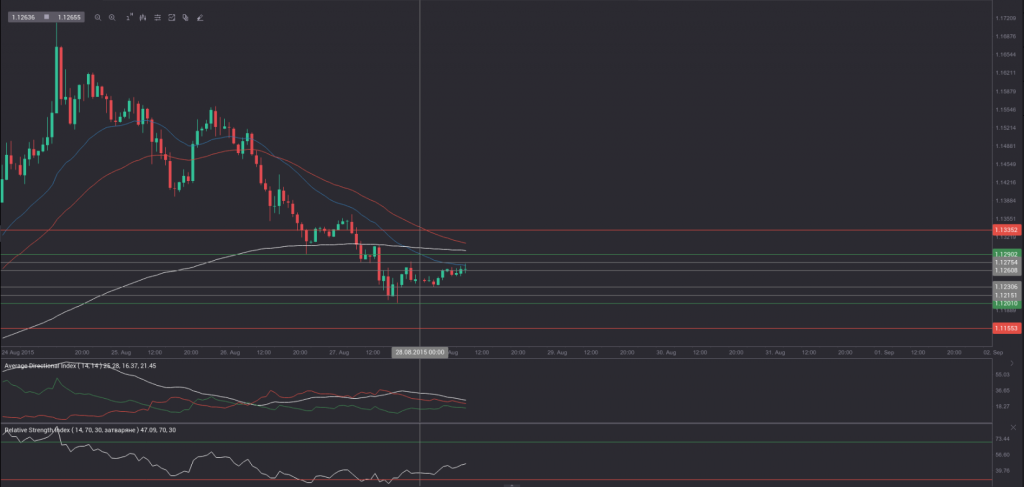Yesterday’s trade saw EUR/USD within the range of 1.1202-1.1366. The pair closed at 1.1245, down 0.63% on a daily basis and marking the third consecutive trading day of losses. The daily low has also been the lowest level since August 20th, when the cross registered a low of 1.1105.
At 6:56 GMT today EUR/USD was up 0.20% for the day to trade at 1.1267. The pair touched a daily high at 1.1270 at 6:51 GMT.
Today the cross may be influenced by a number of macroeconomic reports as listed below.
Fundamentals
Euro area
Economic Sentiment Indicator (ESI)
The final value of the consumer confidence index probably slipped to -6.9 in August, down from a preliminary reading of -6.8, which was reported on August 21st. The final index for July came in at -7.1, or in line with the preliminary value. The indicator measures consumer confidence on a scale of -100 to +100. A reading of -100 suggests a lack of confidence, zero means neutrality and a reading of +100 indicates extreme levels of confidence. The index reflects the level of optimism, which consumers have about economic development in the region. The Business and Consumer Survey is conducted by phone and includes 23 000 households in the Euro area. The questions asked stress on current economic and financial situation, savings intention and also on expected developments regarding consumer price indexes, general economic situation and major purchases of durable goods. This indicator is one of the five major components, that comprise the Economic Sentiment Indicator (ESI).
The ESI probably dipped to 103.9 in August, according to expectations, from a reading of 104.0 in July. The latter has been the highest index level since June 2011, when a value of 105.4 was reported. The Economic Sentiment Indicator (ESI) is a composite indicator, consisting of five sectoral confidence indicators with different weights: Industrial confidence indicator, Services confidence indicator, Consumer confidence indicator, Construction confidence indicator and Retail trade confidence indicator. The ESI is calculated as an index with a mean value of 100.0 and standard deviation of 10 over a fixed standardized sample period.
Lower confidence usually implies lesser willingness to spend, including large-ticket purchases, while consumer spending is a key factor behind economic growth. Therefore, in case either the ESI, or the consumer confidence indicator dropped more than anticipated, this would cause a moderate bearish impact on the euro. The European Commission is expected to release the official ESI reading at 9:00 GMT.
German consumer inflation – preliminary estimate
German preliminary annualized consumer inflation probably remained steady at 0.2% during August, according to the median forecast by analysts. It has been the lowest annual level since February, when a final rate of 0.1% was reported. Julys inflation was driven by a further decrease in energy costs and a slowdown in prices of food.
Energy costs went down 6.2% year-on-year in July, as prices of heating oil plunged 22.4% and prices of motor fuels dropped 7.1%. Prices of other energy products were also down, namely charges for central and district heating (-5.9%) and electricity (-1.0%). On the other hand, prices of solid fuels went up 1.1% year-on-year, according to the report by Destatis. Last month prices of food and non-alcoholic beverages were 0.4% higher compared to July 2014, after in June they climbed another 1.0%.
The nations preliminary annualized CPI, evaluated in accordance with the harmonized methodology, probably rose 0.1% in August, after another 0.1% increase in June and July. The harmonized methodology is used for the sake of consumer inflation comparison in an international context (member states in the Euro area). In case the annualized general CPI slowed down more than expected and further distanced from the 2-percent inflation objective, set by the European Central Bank, this would have a moderate-to-strong bearish effect on the euro, as it would imply that ECBs accommodative monetary policy has not yet produced the desired effect of spurring economic activity. Destatis is scheduled to release the preliminary CPI report at 12:00 GMT.
United States
Personal Income, Personal Spending
Personal spending in the United States probably rose for a third straight month in July, up 0.4%, according to market expectations, while personal income was probably up for a fourth consecutive month in July, increasing at a monthly rate of 0.4%. Spending rose 0.2% in June. Personal consumption expenditures (PCE) were up USD 25.9 billion, or 0.2%, in June.
At the same time, personal income increased 0.4% during the same month, while disposable personal income (DPI) rose USD 60.6 billion (or 0.5%). Private wages and salaries increased USD 16.0 billion in June, compared to a surge by USD 29.6 billion in May. Government wages and salaries went up by USD 2.3 billion, following a USD 2.4 billion increase in the preceding month.
Higher-than-expected rates of increase imply good employment conditions and, therefore, are dollar positive. The Bureau of Economic Analysis is to publish the official figures at 12:30 GMT.
Reuters/Michigan Consumer Sentiment Index – final reading
The monthly survey by Thomson Reuters and the University of Michigan may show that consumer confidence in the United States lowered for a second consecutive month in August. The final reading of the corresponding index, which usually comes out two weeks after the preliminary data, probably came in at 93.0, up from a preliminary value of 92.9, reported on August 14th. In July the gauge of confidence came in at a final reading of 93.1, down from a preliminary value of 93.3. The survey encompasses about 500 respondents throughout the country. The index is comprised by two major components, a gauge of current conditions and a gauge of expectations. The current conditions index is based on the answers to two standard questions, while the index of expectations is based on three standard questions. All five questions have an equal weight in determining the value of the overall index.
According to preliminary data, the sub-index of current economic conditions, which measures US consumers’ views of their personal finances, decreased to a reading of 107.1 in August from a final 107.2 in July. The sub-index of consumer expectations plunged to a flash reading of 83.8 in August, down from a final value of 84.1 in July.
In case the gauge of consumer sentiment showed a larger decrease than anticipated, this would have a moderate bearish effect on the US dollar. The final reading is due out at 14:00 GMT.
Bond Yield Spread
The yield on German 2-year government bonds went as high as -0.213% on August 27th, or the highest level since July 28th (-0.207%), after which it slid to -0.218% at the close to add 0.001 percentage point on a daily basis, while marking a third consecutive trading day of gains.
The yield on US 2-year government bonds climbed as high as 0.715% on August 27th, or the highest level since August 19th (0.738%), after which it fell to 0.700% at the close to add 2 basis points (0.02 percentage point) for the day. It has been a third consecutive trading day of gains.
The spread between 2-year US and 2-year German bond yields, which reflects the flow of funds in a short term, expanded to 0.918% on August 27th from 0.899% during the prior day. The August 27th yield difference has been the most notable one since August 20th, when the spread was 0.918%.
Meanwhile, the yield on German 10-year government bonds soared as high as 0.748% on August 27th, after which it slid to 0.746% at the close to appreciate 3.8 basis points (0.038 percentage point) compared to August 26th.
The yield on US 10-year government bonds climbed as high as 2.207% on August 27th, or the highest level since August 19th (2.230%), after which it slipped to 2.195% at the close to add 1.5 basis points (0.015 percentage point) on a daily basis, while marking a third consecutive day of gains.
The spread between 10-year US and 10-year German bond yields narrowed to 1.449% on August 27th from 1.472% during the prior day. The August 27th yield difference has been the lowest one since August 25th, when the spread was 1.325%.
Daily and Weekly Pivot Levels
By employing the Camarilla calculation method, the daily pivot levels for EUR/USD are presented as follows:
R1 – 1.1260
R2 – 1.1275
R3 (range resistance – green on the 1-hour chart) – 1.1290
R4 (range breakout – red on the 1-hour chart) – 1.1335
S1 – 1.1230
S2 – 1.1215
S3 (range support – green on the 1-hour chart) – 1.1200
S4 (range breakout – red on the 1-hour chart) – 1.1155
By using the traditional method of calculation, the weekly pivot levels for EUR/USD are presented as follows:
Central Pivot Point – 1.1266
R1 – 1.1517
R2 – 1.1645
R3 – 1.1896
S1 – 1.1138
S2 – 1.0887
S3 – 1.0759






